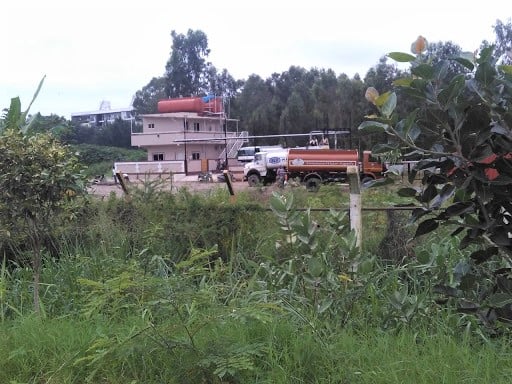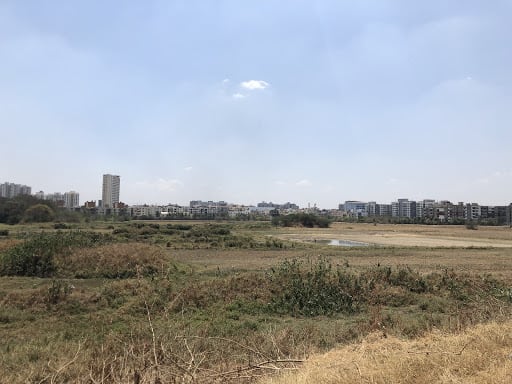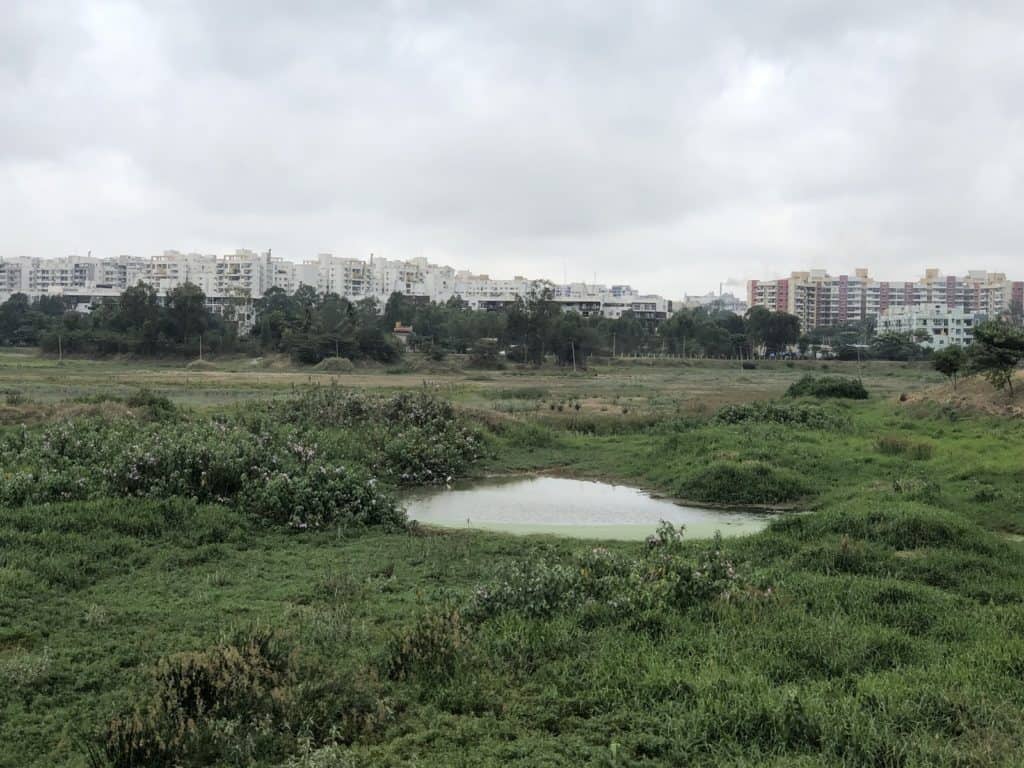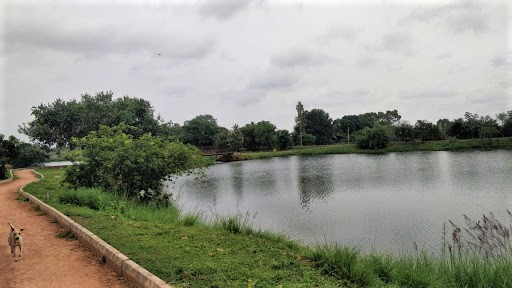Traditionally, Bengaluru’s lakes stay dry for a couple of months, and fill up during the monsoons. This made it easier for potters, brick makers and farmers to collect silt from lakes. But due to climate change, rapid urbanisation and unplanned development, more lakes have been drying up for longer periods of time.
An article by Times of India states that “According to BBMP, about 50% of the lakes have water less than half of their holding capacity. Some of them have gone dry and in others, the water level is fast depleting”. Sowl Kere, Kannamangala lake, Arakere, Sarakki, and Yelahanka Puttenahalli lake are some of these.

In the ‘lake system map’ below, we explore the reasons why some lake beds stay dry most of the year or don’t fill up even during monsoons.

To understand why a lake runs dry, we need to understand the water balance of a lake. Water balance can be explained as the result of gains and losses in a lake. Gains are the actions that increase water quantities in the lake, such as inflows from an upstream lake, rainfall and groundwater. The losses are seen in the form of outflow or overflow, such as evaporation and groundwater recharge. When we add all these factors, it gives us the storage of the lake.
Here is an explanation of the gains and losses in the case of Bengaluru lakes.
Rainfall runoff doesn’t reach many lakes
Rainfall runoff (excess rainfall that can’t be absorbed by the soil) is one of the major inflows into a lake. The catchment of the lake is the immediate area around it from where all the rainfall runoff is directed towards the lake. Due to rapid unplanned urbanisation, the catchment areas of lakes have become fragmented, and natural stormwater channels bringing in water have been blocked or redirected.
Roads built without culverting (under the road/rail drains) prevent runoff from the catchment area reaching the lake. This is the cause of waterlogging in the upstream regions and simultaneous reduction of inflow to the lake. (Read this article in Down to Earth, to learn more about how the catchment area impacts a lake.)
A Supreme Court ruling of 2015 states there should be a buffer of 15-50 metres around stormwater drains (SWDs). But due to lack of enforcement, often there are illegal constructions in and around SWDs. Some SWDs are blocked by the dumping of construction debris, by construction of roads or, in rare cases, the stormwater drain is filled up and built upon. Such construction blocks the only pathway for rainwater to reach the lake.
Sewage leads to silting, more evaporation of lake water
The SWDs that do connect to the lake often carry illegally-discharged domestic sewage and industrial effluents. These contaminants pollute the lake, and in certain circumstances can lead to algal blooms and fish deaths.
One of the preventive measures implemented in many lakes is to divert the SWDs around the lake and to let it flow downstream. This is effective to some extent, but the drawback of this method is that it also prevents rainfall runoff from entering the lake. So despite the lake’s catchment area receiving adequate rainfall, the lake does not get water.
With sewage inflow over time, the lake accumulates silt and sediments from the incoming water. When the lake beds are shallow, the evaporation rate increases. So, silt needs to be removed from time to time, so that it doesn’t reduce the storage capacity of the lake and cause it to dry up during summer.
However, when removing the silt, a proper study and plan needs to be in place to ensure the original lake bed is not disturbed. In many lake beds, the original layer is usually a clayey layer that holds the water in the lake and prevents excess seepage. If the clayey layer is removed, it can result in heavy seepage losses causing the lake to dry up.
Over-extraction of groundwater
Lakes receive and contribute to the groundwater in the region. They are directly affected by the extraction of groundwater through borewells in the immediate adjoining areas. Since BWSSB is unable to supply water to all parts of Bengaluru, people rely more on groundwater to meet their needs. Innumerable borewells are dug in all parts of the city, causing groundwater to be extracted at a much higher rate than it can be recharged.

Over-extraction from borewells depletes groundwater aquifers; the lakes stop receiving groundwater and instead have to contribute to it, increasing the losses from the lake bed. Lack of municipal water supply and lack of enforcement of groundwater regulations aid groundwater exploitation from lake beds. The borewells that are dug around the lake are often used to fill up private water tankers that supply water to the neighborhood.
Bund leakage
The embankment or bund of the lake prevents unwanted outflows from the lake and helps increase its storage capacity. A leakage in the bunds can have serious impact on the water-holding capacity of the lake, and also puts the adjoining population at risk during monsoons as recently observed in Hulimavu lake when the embankment was damaged by an earthmover.
Case studies and solutions
It’s hard to say why exactly a lake does not fill up to its capacity as there can be many reasons for this. For instance, at Sowl Kere, it is suspected that the lake is dry for most parts of the year due to urbanisation, diversion of SWDs and siltation.
With urbanisation, the number of apartments and commercial buildings in the area increased rapidly. Residents here don’t get municipal water supply, so they rely on groundwater and tankers. As the population in this area started rising, numerous borewells were dug in and around the lake.
The SWDs are heavily polluted with sewage. So to prevent any inflow of sewage into the lake, the entry barriers at the SWD inlets to the lake are placed very high. Only when exceedingly large quantities of water flow in the SWD does it overflow into the lake bed.
A team from BIOME, ATREE and Commonstudios are working along with others, including the lake custodian at Sowl Kere, MAPSAS, on a pilot study for an in-stream treatment solution. It is a decentralised treatment method to treat the wastewater flowing in the SWD. So instead of diverting the water away from lakes, clean water can flow into lakes.
The image below is what Sowl kere looks like for most of the year. Even though it does fill up during the monsoon season, it does not fill up to capacity or overflow at the outlet as it is designed to.


Another instance of a lake not filling up to capacity used to be Kannamangala lake. The lake is located in East Bengaluru’s Mahadevapura zone, which is a peri-urban area with both farmland and houses/apartments. Residents here too don’t get municipal water supply, and rely on groundwater and tankers.
There were 4-5 borewells of 800-1000ft depth dug inside the lake, as the groundwater levels are very low. Additionally, silt accumulation in the lake was really high and there was a leakage in the bund, which would impact the neighbouring farmland whenever the lake overflowed.
To fill Kannamangala lake, some of the overflow from Yellamallapa Chetty lake was diverted into it. ForceGW, a federation of local Resident Welfare Associations (RWAs), came together to rejuvenate the lake. They desilted the lake, fixed the leakage in the bund, strengthened the bund by planting Vetiver, cleared the garbage that was being dumped into the lake and also allowed STP-treated water from nearby apartments to be released into the lake.
The lake no longer needs water to be pumped from the other lake to fill up to capacity, and also recharges the aquifers. The borewells inside the lake are no longer being used. ForceGW was successfully able to prevent the lake from drying up and increase groundwater levels in the region.


What can you do?
Much of the responsibility for preventing the drying up of lakes is in the hands of the government. However, citizens can hold government agencies accountable. The lake custodian can be the first point of contact when issues arise. BBMP is the lake custodian for most lakes within city limits; they can be contacted at 080- 2266 0000 in the following cases:
- If the lake is receiving insufficient inflows, to see if diverted stormwater or treated STP water can be released into the lake
- To clean any debris or waste in SWDs or to report encroachment of SWD
- To prevent sewage from flowing into stormwater drains
- To regularly desilt lake beds, ensure a proper study is conducted to identify the depth of the lake bed and to have a plan for the silt that is removed
- For regular maintenance of bunds, to prevent any leak or breach in the bund
Additionally, you can:
- Install rainwater harvesting systems in your home to meet at least some of your water demand. This would reduce the amount of water you’d need from BWSSB, tankers and borewells. Follow these links to learn more about rainwater harvesting and rainwater harvesting regulations in Bengaluru.
- Build recharge wells, as it helps replenish aquifers. It is a law in Bengaluru that if you live within BBMP’s jurisdiction or have a BWSSB connection, you need to have a recharge well. Learn more about recharge wells here.
- Prevent concretisation of land and increase green cover, as it reduces rainfall runoff and increases groundwater recharge
Resources:
[This Lake System Map series is created by Bangalore Citizen Science Lakes Dashboard. It is an initiative by the Center for Social and Environmental Innovation (CSEI) at Ashoka Trust for Research in Ecology and the Environment (ATREE) and Biome Environmental Trust (BIOME) to share knowledge and best practices for better management of lakes. The system maps were developed by consulting experts, in collaboration with Janagraaha.]